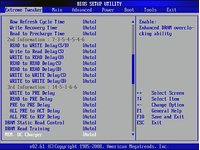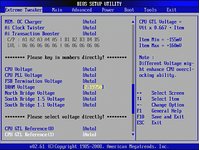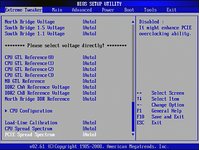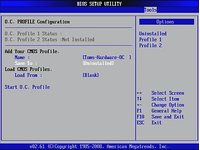11-Way P45 Motherboard Shootout
Maximus II Formula BIOS And Overclocking
| FSB Frequency | 200 to 800 MHz (1 MHz) |
| Clock Multiplier Adjustment | Yes |
| DRAM Ratios | 1.0, 1.2, 1.33, 1.25, 1.5, 1.60, 1.67, 2.0 |
| PCIe Clock | 100 to 200MHz (1 MHz) |
| CPU Vcore | 0.85 to 2.50 Volts (0.00625 Volts) |
| CPU FSB Voltage | 1.10 to 2.001 Volts (0.01325 Volts) |
| Northbridge (MCH) | 1.10 to 2.054 Volts (0.01325 Volts) |
| Southbridge (ICH) | 1.50 to 2.0565 Volts (0.01325 Volts) |
| DRAM Voltage | 1.80 - 3.40325 Volts (0.01325 Volts) |
| CAS Latency Range | tCAS:3-11 ; tRCD : 3-18 ; tRP : 3-18 ; tRAS : 3-34 |
The Maximus II Extreme is intended to support extreme overclocking, so it includes excessively wide voltage ranges and every possible Intel memory multiplier.
The Extreme Tweaker menu is found first in Maximus II Formula BIOS, and starts with the “CPU Level Up” setting which can approximate the speed of a faster processor by automatically increasing bus speeds to match the desired final speed. Our Core 2 Duo is already the fastest Conroe however, so the only setting found here is “Crazy”. Ai Overclock Tuner will increase and decrease FSB clock automatically in response to system load, but experienced overclockers will find the highest performance through a wide range of manual settings.


Scroll past the full set of memory timings to reveal voltage controls.


The bottom of the Extreme Tweaker menu provides all the needed reference voltage controls to squeeze out the last possible bit of performance.
Final settings can be stored to a BIOS profile or saved to a USB drive. This prevents settings from being lost if BIOS needs to be cleared following a boot failure.
Get Tom's Hardware's best news and in-depth reviews, straight to your inbox.
Current page: Maximus II Formula BIOS And Overclocking
Prev Page Maximus II Formula Onboard Devices Next Page Maximus II Formula Software And Accessories-
nickchalk Where are the lower price P45 M/B ?Reply
Asus P5Q pro is out for €110 and P5Q deluxe for €165 the price difference is about 70$ in Greece. -
Proximon I suppose I can get some good from having read this. Did you get paid by the word? Maybe next time you could just put together a complete features chart so that we can have some convenient comparison? You know, so someone could go to a chart and see at a glance which boards had eSATA or firewire, or 8 USB.Reply
-
JPForums I'd rather have the overabundance of information than a lack of information. Presentation could use a little refining (I.E. comparison charts and the likes), but having the relevant information available at least is a good thing.Reply -
the introduction and specifics are nice, the comparision isn't. so, why don't you test with an 8500 or qx9650? 6850 are outdated... and a mobo handling a c2d doesn't mean it can handle a quad too, see P5K for example (it stinks when it comes to a q6600).Reply
-
Crashman procithe introduction and specifics are nice, the comparision isn't. so, why don't you test with an 8500 or qx9650? 6850 are outdated... and a mobo handling a c2d doesn't mean it can handle a quad too, see P5K for example (it stinks when it comes to a q6600).Reply
Tom's Hardware wants the performance of current articles to reflect that of recent articles, so a "standard test platform" was chosen a while ago. It will get updated, but probably not before the new socket becomes widely available. -
zenmaster I would have liked to see something such as a P35 and an X48 as controls to help analyze the P45 Performance.Reply
In otherwords, What is the P45 Gaining me over the older P35.
What would I gain by going to the X48. (Or Lose) -
Crashman zenmasterI would have liked to see something such as a P35 and an X48 as controls to help analyze the P45 Performance.In otherwords, What is the P45 Gaining me over the older P35.What would I gain by going to the X48. (Or Lose)http://www.tomshardware.com/reviews/intel-p45-chipset,1961.htmlReply -
johnbilicki The first 17 pages were filled with nothing but junk from ASUS. Do us a favor: don't even bother featuring or *MENTIONING* anything for any reason from a company that refuses to RMA 200-400 dollar brand new motherboards with anything other then used and usually broken junk. It destroyed my enthusiasm for the article.Reply -
dobby nickchalkWhere are the lower price P45 M/B ?Asus P5Q pro is out for €110 and P5Q deluxe for €165 the price difference is about 70$ in Greece.Reply
the p5q PRo is a p43 board, i should know i have one

